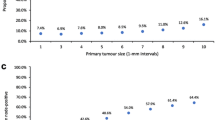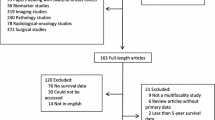Abstract
Background: Tumor size affects the choice of surgical procedure and patient prognosis. It is standardly assessed as the largest unidimensional measurement and, for multifocal disease, as the largest size of the largest focus. We examine some different methods of assessing tumor size: the standard method; the sum of the largest sizes for all foci; surface area; and volume.
Methods: Data for a cohort of 678 primary invasive breast cancer patients accrued from 1971 to 1990 were updated to 1996; there were 571 patients with unifocal disease and 107 patients with multifocal disease. We used step-wise Cox regression to investigate the effects on time to death of the prognostic factors tumor size (estimated in one of the four ways), age, nodal status, ER, PgR, adjuvant radiotherapy, adjuvant hormonal therapy, and adjuvant chemotherapy. We also examined the association between tumor focality and nodal status.
Results: For all patients, tumor size was included in the multivariate model, regardless of estimation method. For patients with multifocal disease, tumor size was included in the final model only when it was estimated as the total surface area (P=.03) or volume (P=.01) of the foci. More multifocal patients were N+ (P=.056).
Conclusions: For patients with multifocal disease, the significance association with mortality for total surface area or volume may imply a biologic relevance or mode of tumor activity for the foci.
Similar content being viewed by others
References
Gundersen HJG, Bendtsen TF, Korbo L, et al. Some new, simple and efficient stereological methods and their use in pathological research and diagnosis.APMIS 1988;96:379–94.
Gundersen HJG, Bagger P, Bendtsen TF, et al. The new stereological tools: dissector, fractionator, nucleator and point sampled intercepts and their use in pathological research and diagnosis.APMIS 1988;96:857–81.
LaRoye GJ, Panzarella T. Two techniques for measuring invasion in solid tumours. Evaluated in a retrospective study of 73 cases of breast carcinoma with 10-year follow-up.APMIS 1994;102:103–11.
Fish EB, Chapman JW, Link MA. Minimal surgery for breast cancer.Proceedings of the 16th International Cancer Congress, New Delhi, India. Bologna, Italy: Monduzzi Editore, 1994:1387–91.
Fish EB, Chapman JW, Link MA. Discriminant analyses of minimal versus maximal surgery for breast cancer.Breast Cancer Research and Treatment 1994;32(Suppl):69. Abstract.
Fish EB, Chapman JW, Link MA. Competing causes of death for primary breast cancer.Breast Cancer Research and Treatment 1996;37(Suppl):54. Abstract.
Chapman JW, Fish EB, Link MA. Competing risks analysis for recurrence from primary breast cancer.Breast Cancer Research and Treatment 1996;37(Suppl):57. Abstract.
Koscielny S, Tubiana M, Le MG, Valleron AJ, Mouriesse H, Contesso G, Sarrazin D. Breast cancer: relationship between the size of the primary tumour and the probability of metastatic dissemination.Br J Cancer 1984;49:709–715.
Sivaramakrishna R, Gordon R. Detection of breast cancer at a smaller size can reduce the likelihood of metastatic spread: a quantitative analysis.Acad Radiol 1997;4:8–12.
Author information
Authors and Affiliations
Rights and permissions
About this article
Cite this article
Fish, E.B., Chapman, JA.W. & Link, M.A. Assessment of tumor size for multifocal primary breast cancer. Annals of Surgical Oncology 5, 442–446 (1998). https://doi.org/10.1007/BF02303863
Received:
Accepted:
Issue Date:
DOI: https://doi.org/10.1007/BF02303863




